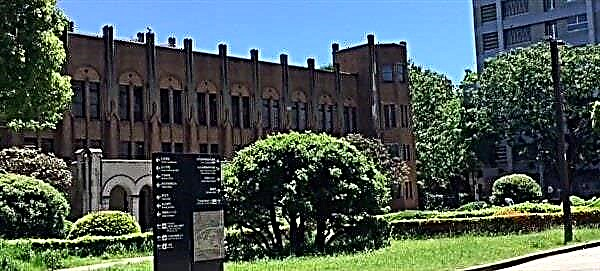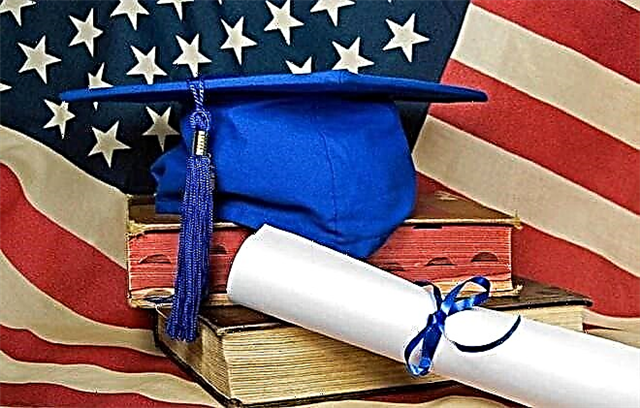Higher education in the United States is associated with quality, high prices, and great prospects for graduates. It is indicative that almost 50% of Nobel laureates received their diplomas from American universities. In this state, there are more than 4,000 higher educational institutions, whose students are almost 20 million people.
The structure of the US educational system
The education system in the United States does not exist as a single set of rules and canons for all educational institutions in the country. All issues related to education are resolved at the state level. This decentralization provides a wide variety of educational institutions with individually designed curricula, different content, teaching methods, philosophy and traditions.
The US Department of Education sets only basic standards, which are finalized at the local level and controlled by federal regents (observers).
The first thing that distinguishes education in the United States from Russia is the duration of the school stage of education. The length of the school is determined by the state. Children go to school from 5-8 years old and finish it at 18-19 years old.
The school may be preceded by a kindergarten. This is followed by the zero grade, the so-called pre-school. In many regions of the country, it is not compulsory, but still, most parents prefer that the child does not miss this year.
The elementary school lasts until grades 5-6, after which the student moves to middle school, where he studies up to grade 8 inclusive. High school includes grades 9 through 12.
The end of High School is marked by the passing of final exams - SAT I or SAT II. They differ in the level of complexity and focus.
The first exam is for those planning to go to college or mid-level university. The second is designed for those wishing to become students of prestigious universities.
The successful completion of final exams is evidenced by a diploma confirming the receipt of a complete secondary education.
American higher education system
Education in American universities is also multi-stage. For the first 4 years, the student masters the chosen specialization and receives a diploma that will allow him to work in the profession.
Those who wish to deepen their knowledge can enter the magistracy and unlearn for another 2-3 years. Further education at the university is designed for those who want to devote themselves to science.
Education at the university is divided into several stages:
- A bachelor's degree in the United States is available at any higher education institution in the country. It usually lasts 4 years. Admission of applicants is carried out on the basis of final school exams and a letter of motivation. In the second document, the prospective student must indicate why he wants to study at this particular university. It needs to be backed up by the recommendations of teachers from the secondary school graduated from. After graduating, students take exams and defend their theses. After that, the university issues the student with a bachelor's degree diploma (Bachelor's Degree).
- At the second stage of higher education, students will have to complete a master's program. It is distinguished by its extensive research activities. The program lasts 1-2 years (for doctors 3-4 years). Upon completion, a Master's Degree will be issued. In the field of economic knowledge, an MBA (Master of Business Administration) diploma is issued.
- The third level corresponds to Russian doctoral studies and is called Advanced Professional Degree. The program lasts 2-3 years. During this time, students write a dissertation, attend seminars, lectures. After defending their work, they receive a PhD (Doctoral Level) - Doctor of Philosophy, with the addition of specialization. For example, a Ph.D. in chemistry.
- The final stage is the most prestigious and is called the Postgraduate Level or Postdoctoral Level. Only candidates of sciences who have defended more than one scientific or research work can go to this level. The training program includes work on a thesis project, attending a few lectures and seminars (most often on an individual basis), teaching at the university in which the program is being mastered.
Types of educational institutions
The higher education system in the United States is represented by colleges, little-known universities, and famous universities that have gained fame at the global or national level.
Higher education institutions in America have the following characteristics:
- Colleges - they have poorly developed or no scientific programs and no research activities. A college degree is considered less prestigious, although there is a perception that some liberal arts colleges may well compete with renowned universities.
- Universities - on their basis, students are engaged in extensive research work and can study in graduate school. Theoretical knowledge in such universities is supported by constant practice. All universities are divided into two types:
- Private - they are considered to provide the best training (in some cases this is not the case). The list of well-known private universities includes some universities from the Ivy League (an association of 8 educational institutions located in 7 states), for example, Harvard or Yale.
- State universities are fully funded from the state treasury. Because of this, they are classified as inexpensive educational institutions. Education received at a state university is considered less prestigious, although many of them are engaged in serious scientific activities.
The best universities in the country are those that are part of the Ivy League:
- Harvard University (Massachusetts);
- Yale University (Connecticut);
- Brown University (Rhode Island);
- Dartmouth College (Massachusetts);
- Columbia (New York State);
- Cornell (New York);
- Pennsylvania (Pennsylvania);
- Princeton (New Jersey).
Getting a degree from one of these universities is considered prestigious because it opens up broad prospects in the professional career of graduates. There are three main reasons that form a respectful attitude towards the League: exceptional quality of education, competition for admission and belonging to the social elite.
List of popular universities in the country
It is very difficult to decide on the choice of an educational institution for those who want to get a second higher education in the USA or master their first profession. The study of various ratings and top-lists of popular universities will help in this.
Here is a list of universities that you should pay attention to (the list contains universities ranking in their direction from different regions of the country):
- City College of New York is one of the most famous public institutions, founded in 1847 and part of City University of New York. About 15 thousand students study here. Located in the famous Manhattan area, in the heart of the business capital of the world. It offers bachelor's degrees in arts, science and technology, as well as master's degrees in public administration, arts, architecture, science, social work and pedagogy.
- Yale University - located in New Haven (Connecticut), is one of 8 Ivy League universities. Founded in 1701, it includes 12 divisions in which you can get medical education, legal, theological, musical, as well as master a profession in the field of exact and humanitarian sciences, natural knowledge, acting and business.
- Northwestern University is one of the leading private research universities in the country, located in Evanston, Illinois, and teaching about 20,000 students. Founded in 1851. He is the founder of the Nemmers Prize, which is awarded for significant achievements in the field of mathematics. 19 Nobel laureates, 38 Pulitzer Prize winners, 65 members of the American Academy of Arts and Sciences studied and taught here. The University hosts the Weinberg College of Arts and Sciences, the School of Applied and Engineering Sciences, the School of Communication, the School of Journalism, the School of Music, and the School of Professional Education and Social Policy.
- Bard College - Located in Annandale-on-Hudson, New York. Famous private liberal arts college, university of liberal arts and sciences. Belongs to the list of National Historical Monuments of the United States. The year of foundation - 1860. Education here can be obtained at 4 specialized faculties: foreign languages and literature, natural sciences and mathematics, art, social research. There are 260 teachers for 2050 students at the university, which indicates a high level of quality of the knowledge provided.
- Princeton University - located in the state of New Jersey in the city of Princeton. Founded in 1746. Grants degrees in areas such as natural sciences, humanities, engineering and social sciences. There is no school of business, law or medicine, but you can get a professional degree at the School of International and Public Relations. W. Wilson, School of Applied Sciences, School of Architecture.
- Harvard University is one of the oldest universities in the United States and the world. Founded in 1636, located in Massachusetts in Cambridge. Its alumni are 75 Nobel laureates. The university includes 7 faculties. The largest division is the Faculty of Arts and Sciences. The university also includes the School of Medicine, School of Law, Graduate School of Design, Institute of Theology, JF Kennedy Institute of Public Administration.
- Stanford University - supplies high-class IT specialists, occupies the first positions in many rankings.
Directions and specialties
For those who are concerned with the question of how to move to study in the United States, a short overview of the main areas and specialties that can be mastered in local universities will be useful. Based on what is offered in the labor market, the most profitable investments will be in a medical degree and all programs and courses related to law.
America is a country of lawyers and courts, which means that a good lawyer will not be left without a job.
Medical services in the States are expensive, and the number of private clinics outnumbered public hospitals. Doctors here are well paid, but to start practicing, you have to unlearn 10-15 years.
Another area worth paying attention to is music. Children begin to study this subject as a specialized one from the 8th grade. The prestigious specialized universities in the country are The Juilliard School, Curtis Institute of Misic, Berkeley College, Hollywood Institute of Music, Tanglewood College of Music.
IT education is best obtained at the Silicon Valley Campus at the University of California at Santa Cruz. It is located in the heart of Silicon Valley. All programs of the university are focused on entrepreneurship, global business and innovation.
The United States is of particular interest to those who dream of a prestigious economic education. The list of rating universities where you can master this direction includes:
- Florida South College,
- Stanford University,
- Boston University,
- Harvard University,
- University of Chicago.
How is admission going
Having decided on the educational institution, you can move on to the question of how to enter an American university. There are no restrictions for foreigners. A Belarusian, a Ukrainian, a Russian, and a Kazakh can become a student of a university or college. The main thing is that there are enough funds and the applicant meets the requirements.
The selection committee evaluates candidates according to many criteria: grades in the school certificate, academic achievements, recommendations from teachers, and the presence of talents.
It is important to remember that it is impossible for residents of the CIS countries to enter a US university (as well as at home) after the 9th grade. To do this, you will have to finish another professional technical school or get a complete secondary education.
Preparing documents
Enrollment in some universities is based on the results of assessing previous performance. If everything goes well, the university will send an invitation, on the basis of which a student visa to the United States is opened.
The main document in the package of papers is the application form. It can always be downloaded from the website of the selected educational institution. Some of the questions in it can be thematic and require an answer in the form of an essay. For example, "What was the last book you read?"
The package of documents includes:
- Completed application form.
- Motivation letter.
- A receipt for payment of the application fee (up to $ 150).
- Guaranteed availability of funds (account statement or sponsorship letter).
- A transcript, the so-called transcript (if the applicant has already studied for some time at a university in his country) or a school certificate with translation and notarization.
- Certificate of passing the TOEFL or IELTS exam (level of knowledge of English).
- Letters of recommendation from teachers.
If a candidate from, say, Russia has already received a basic higher education at his home university and wants to continue his studies for an academic degree in the United States, he will need confirmation of a Russian diploma (nostrification). This is done by special commissions that decide which marks can be counted and which are not.
Sometimes the degree is demoted. For example, you received a master's degree, but you were awarded only a bachelor's degree. This practice is normal, since there is a difference in the curricula of Russian and American universities.
Exams
The procedure for passing the entrance campaign and exams for admission to an American university are always spelled out on the website of the educational institution.
Applicants have the opportunity to send an application to several universities at once. To do this, you can use an electronic system that will automatically send your request to the institutions that interest you. For example, Common Application will do.
If you received your previous education in a language other than English, you must pass the TOEFL exam. For some programs, for example, design or architecture, you need to prepare a portfolio.
Tests for admission to the university are taken by those who apply to become a student of a prestigious university. These are most often ACT or SAT - exams that all American students take when they graduate from school (analogous to the Russian Unified State Exam).
Distance learning opportunity
Some American universities provide distance learning opportunities. This is especially true for foreign students who can get a diploma from one of the most prestigious universities in the world without leaving their homeland.
This approach is commonly called the program of the future. It provides distance education in America through modern technology and communication.
Having submitted a package of documents to a particular university, the applicant is enrolled in the ranks of students and a certain teacher is assigned to him. To obtain a master's degree, you will need to attend 12 courses, the duration of each of which is 2.5 months.
All test and other tasks are sent by email. If an oral test is required, Skype and other applications are used to make eye contact possible. Upon graduation, the university sends a diploma to the post office.
What is included in the training program
The academic year in US universities lasts about 9 months and is divided into semesters (sometimes trimesters). There is no single curriculum here.
Each university develops its own curriculum, which is varied and flexible. New students are admitted in spring and autumn, so you can start studying at a convenient time.
There is also no concept of an academic group and a timetable that is the same for everyone. Each student chooses the courses he wants to attend.
All subjects are divided into compulsory and optional. Each discipline assumes a certain number of credits (points). To obtain one degree or another, you need to collect a strictly established number of such credit units.
To get a loan, you need to get a good grade in the subject:
- F - unsatisfactory (0);
- D - satisfactory (1);
- C - good (2);
- B - excellent (3) ;;
- A - excellent (4);.
From all the marks received, the average score (GPA) is calculated, which shows whether the subject has been passed or not.
The first two years of study are usually devoted to general subjects. By the end of this period, the student must decide what his further specialization will be, since the list of narrowly focused disciplines will depend on this.
Mastering a profession at the university is closely related to scientific research. That is why there is an opportunity to become an assistant or assistant professor.
Classes are divided into lectures and seminars. The second involves studying literature from the list prepared by the teacher, doing homework, sometimes laboratory work, discussing cases and applying knowledge in practice.
How much does an American education cost?
Prices for education in the States depend on the prestige of the university and the chosen program. You need to be prepared for the fact that a future student will need a considerable budget.
Tuition fees in the USA in some universities, 1 semester in $ for a bachelor's degree:
University of Pennsylvania - 20,000-23,000;
Stanford University - 18,000-24,000;
University of Chicago - 22,600-24,600;
Harvard - 16,000-25,000;
Princeton University - 20,000-25,000;
New York Film Academy - 14,000-24,000;
University of Notre Dame - 16 100-27 200.
Is it possible to count on a scholarship
There are several types of scholarships in the United States:
- Scholarship - usually covers tuition and housing costs. Provided by the state or by the institution itself.
- Fellowship - provided by scientific societies for the training of graduate students, doctors and candidates of science who are members of such organizations.
- Grant is a top tier scholarship. Those who are engaged in some interesting scientific research can get a grant to study in the United States. The sponsor can be an interested organization.
- Assistantship - assistant work. Receiving this type of material assistance requires, in return, performing a certain type of work, for example, assistance to the supervisor in conducting scientific research. Usually graduate students can count on it.
Since free education in the United States is not possible even for citizens of the country, you can use one of the following types of financial assistance:
- Loans - loans that can be provided directly by the university itself or the state government.
- Sponsorship - sponsorship. You can get it from a charity, company, or even an individual.
Help can be hidden. If a student writes a letter to the rector and explains why he cannot pay for his studies, the university can meet halfway and reduce the amount of payments.
Student life
Most of the youth live on student campuses, which resemble small towns with developed infrastructure. As a rule, on their territory you can find everything that young people need for a fulfilling life, from a library, sports fields and football fields, to cafes and shops.
Students usually eat in university canteens. In general, the list of expenses looks like this:
- Accommodation in a hostel - $ 1,000-1,500 per month, including meals.
- Annual insurance - $ 1,200.
- Textbooks and teaching materials - $ 1,000 per year.
- Clothing, unforeseen expenses, entertainment - about $ 1,500-2,000 for 1 academic year.
- Public transport - most universities are covered by university funds.
Students can work during their studies only on campus and no more than 20 hours a week. On average, living and food costs can be as high as $ 30,000 a year.
Internship
The advantage of studying in the United States is the opportunity to undergo an internship in an American company. Many educational institutions maintain close contacts with national employers and foreign partners.
But in order to gain such experience, you will have to seriously approach the issue of academic performance.
Only the most promising and persistent students can receive an invitation from the company. A bonus after completing an internship can be an invitation to work after graduation.
You can find out with which enterprises the university cooperates in the Department for Work with Students, which is at each educational institution. Planning an internship should start from the very first year of study.
Outcomes
To summarize, here is a comparative table of the pros and cons of studying in the United States:
| Advantages | disadvantages |
|---|---|
| the possibility of getting an education in one of the world-famous universities; | high cost of training; |
| American universities can be called non-standard, since various monopolies invest money in them, that is, a significant budget is spent on research activities; | high associated costs; |
| a diploma that is recognized in most of the countries of the world; | high requirements for applicants; |
| job prospects; | territorial remoteness; |
| living in a country rich in history, culture and traditions; | difference in mentality. |
| a residence permit for the entire period of study; | |
| quality education; | |
| access to the best libraries in the world; | |
| the opportunity to engage in research activities; | |
| living in an English-speaking environment. |
Generally speaking, getting an education in the United States is worth saving up and investing in your future profession.











